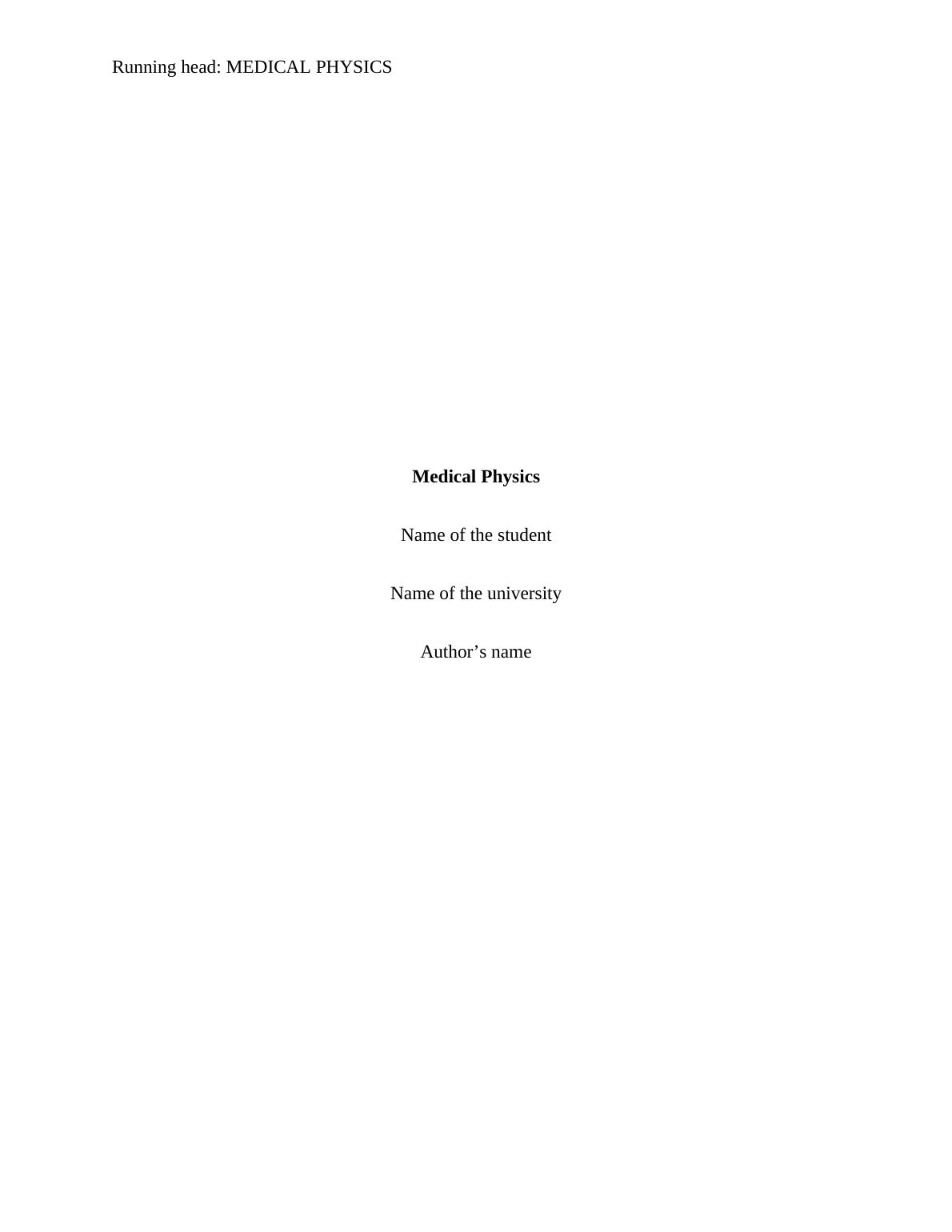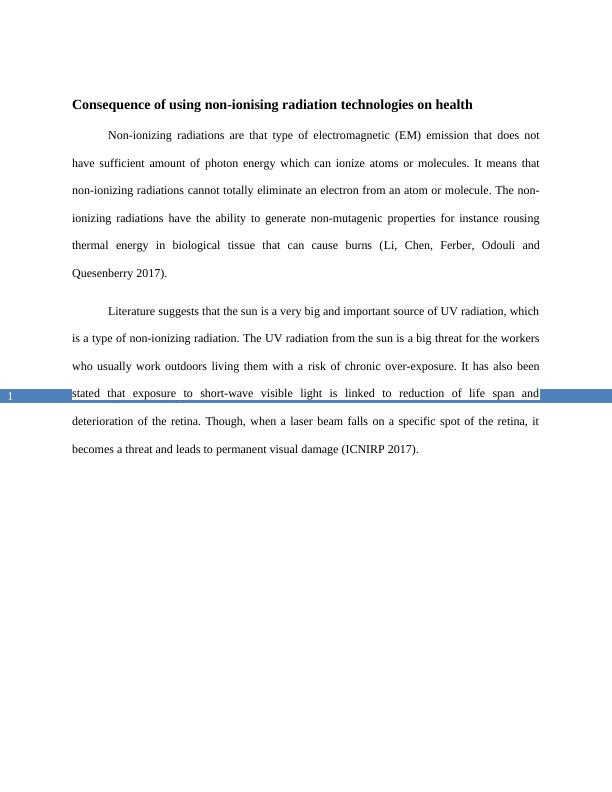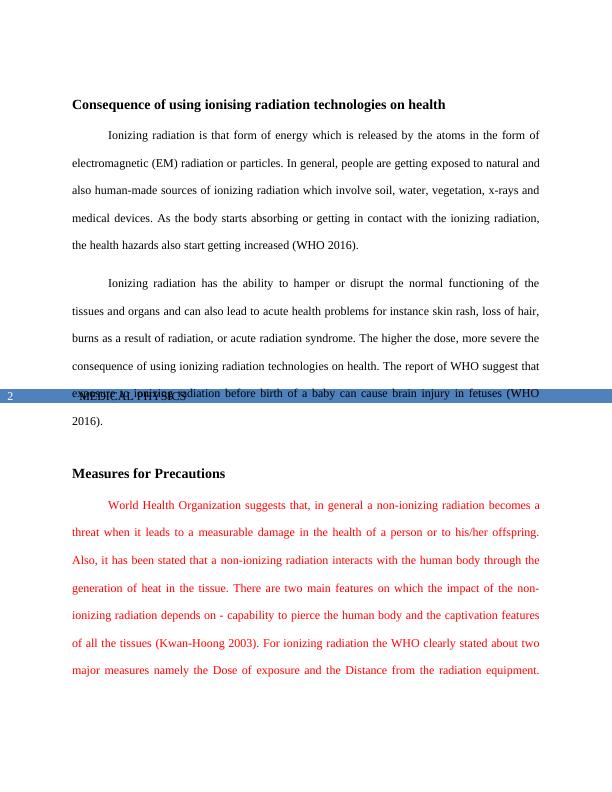International Journal of Engineering Science
Added on 2022-08-21
6 Pages949 Words16 Views
Running head: MEDICAL PHYSICS
Medical Physics
Name of the student
Name of the university
Author’s name
Medical Physics
Name of the student
Name of the university
Author’s name

MEDICAL PHYSICS1
Consequence of using non-ionising radiation technologies on health
Non-ionizing radiations are that type of electromagnetic (EM) emission that does not
have sufficient amount of photon energy which can ionize atoms or molecules. It means that
non-ionizing radiations cannot totally eliminate an electron from an atom or molecule. The non-
ionizing radiations have the ability to generate non-mutagenic properties for instance rousing
thermal energy in biological tissue that can cause burns (Li, Chen, Ferber, Odouli and
Quesenberry 2017).
Literature suggests that the sun is a very big and important source of UV radiation, which
is a type of non-ionizing radiation. The UV radiation from the sun is a big threat for the workers
who usually work outdoors living them with a risk of chronic over-exposure. It has also been
stated that exposure to short-wave visible light is linked to reduction of life span and
deterioration of the retina. Though, when a laser beam falls on a specific spot of the retina, it
becomes a threat and leads to permanent visual damage (ICNIRP 2017).
Consequence of using non-ionising radiation technologies on health
Non-ionizing radiations are that type of electromagnetic (EM) emission that does not
have sufficient amount of photon energy which can ionize atoms or molecules. It means that
non-ionizing radiations cannot totally eliminate an electron from an atom or molecule. The non-
ionizing radiations have the ability to generate non-mutagenic properties for instance rousing
thermal energy in biological tissue that can cause burns (Li, Chen, Ferber, Odouli and
Quesenberry 2017).
Literature suggests that the sun is a very big and important source of UV radiation, which
is a type of non-ionizing radiation. The UV radiation from the sun is a big threat for the workers
who usually work outdoors living them with a risk of chronic over-exposure. It has also been
stated that exposure to short-wave visible light is linked to reduction of life span and
deterioration of the retina. Though, when a laser beam falls on a specific spot of the retina, it
becomes a threat and leads to permanent visual damage (ICNIRP 2017).

MEDICAL PHYSICS2
Consequence of using ionising radiation technologies on health
Ionizing radiation is that form of energy which is released by the atoms in the form of
electromagnetic (EM) radiation or particles. In general, people are getting exposed to natural and
also human-made sources of ionizing radiation which involve soil, water, vegetation, x-rays and
medical devices. As the body starts absorbing or getting in contact with the ionizing radiation,
the health hazards also start getting increased (WHO 2016).
Ionizing radiation has the ability to hamper or disrupt the normal functioning of the
tissues and organs and can also lead to acute health problems for instance skin rash, loss of hair,
burns as a result of radiation, or acute radiation syndrome. The higher the dose, more severe the
consequence of using ionizing radiation technologies on health. The report of WHO suggest that
exposure to ionizing radiation before birth of a baby can cause brain injury in fetuses (WHO
2016).
Measures for Precautions
World Health Organization suggests that, in general a non-ionizing radiation becomes a
threat when it leads to a measurable damage in the health of a person or to his/her offspring.
Also, it has been stated that a non-ionizing radiation interacts with the human body through the
generation of heat in the tissue. There are two main features on which the impact of the non-
ionizing radiation depends on - capability to pierce the human body and the captivation features
of all the tissues (Kwan-Hoong 2003). For ionizing radiation the WHO clearly stated about two
major measures namely the Dose of exposure and the Distance from the radiation equipment.
Consequence of using ionising radiation technologies on health
Ionizing radiation is that form of energy which is released by the atoms in the form of
electromagnetic (EM) radiation or particles. In general, people are getting exposed to natural and
also human-made sources of ionizing radiation which involve soil, water, vegetation, x-rays and
medical devices. As the body starts absorbing or getting in contact with the ionizing radiation,
the health hazards also start getting increased (WHO 2016).
Ionizing radiation has the ability to hamper or disrupt the normal functioning of the
tissues and organs and can also lead to acute health problems for instance skin rash, loss of hair,
burns as a result of radiation, or acute radiation syndrome. The higher the dose, more severe the
consequence of using ionizing radiation technologies on health. The report of WHO suggest that
exposure to ionizing radiation before birth of a baby can cause brain injury in fetuses (WHO
2016).
Measures for Precautions
World Health Organization suggests that, in general a non-ionizing radiation becomes a
threat when it leads to a measurable damage in the health of a person or to his/her offspring.
Also, it has been stated that a non-ionizing radiation interacts with the human body through the
generation of heat in the tissue. There are two main features on which the impact of the non-
ionizing radiation depends on - capability to pierce the human body and the captivation features
of all the tissues (Kwan-Hoong 2003). For ionizing radiation the WHO clearly stated about two
major measures namely the Dose of exposure and the Distance from the radiation equipment.

End of preview
Want to access all the pages? Upload your documents or become a member.
Related Documents
Anti-Radiation System for Residents: Manufacturing and Business Feasibilitylg...
|13
|3018
|371
Acute Radiation Syndrome: Dose, Types, Diagnosis, and Managementlg...
|9
|2456
|79
Effect of Mobile Radiation on Human Health Report 2022lg...
|13
|2702
|46
